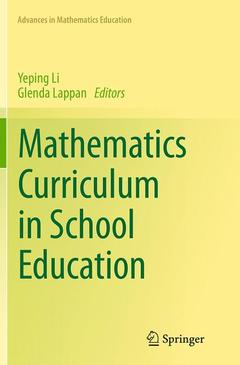Mathematics Curriculum in School Education, Softcover reprint of the original 1st ed. 2014 Advances in Mathematics Education Series
Coordonnateurs : Li Yeping, Lappan Glenda

Mathematics curriculum, which is often a focus in education reforms, has not received extensive research attention until recently. Ongoing mathematics curriculum changes in many education systems call for further research and sharing of effective curriculum policies and practices that can help lead to the improvement of school education.
This book provides a unique international perspective on diverse curriculum issues and practices in different education systems, offering a comprehensive picture of various stages along curriculum transformation from the intended to the achieved, and showing how curriculum changes in various stages contribute to mathematics teaching and learning in different educational systems and cultural contexts.
The book is organized to help readers learn not only from reading individual chapters, but also from reading across chapters and sections to explore broader themes, including:
- Identifying what is important in mathematics for teaching and learning in different education systems;
- Understanding mathematics curriculum and its changes that are valued over time in different education systems;
- Identifying and analyzing effective curriculum practices;
- Probing effective infrastructure for curriculum development and implementation.
Mathematics Curriculum in School Education brings new insights into curriculum policies and practices to the international community of mathematics education, with 29 chapters and four section prefaces contributed by 56scholars from 14 different education systems. This rich collection is indispensable reading for mathematics educators, researchers, curriculum developers, and graduate students interested in learning about recent curriculum development, research, and practices in different education systems.
It will help readers to reflect on curriculum policies and practices in their own education systems, and also inspire them to identify and further explore new areas of curriculum research for improving mathematics teaching and learning.
Date de parution : 09-2016
Ouvrage de 663 p.
15.5x23.5 cm
Date de parution : 12-2013
Ouvrage de 663 p.
15.5x23.5 cm
Disponible chez l'éditeur (délai d'approvisionnement : 15 jours).
Prix indicatif 105,49 €
Ajouter au panierThème de Mathematics Curriculum in School Education :
Mots-clés :
Cross-national comparison mathematics curriculum; International perspective mathematics curriculum; Mathematics Curriculum development; Mathematics Curriculum implementation; Mathematics Curriculum policy; Mathematics Curriculum research; Mathematics curriculum and student learning; Mathematics curriculum and teaching; Mathematics curriculum practice; School mathematics



